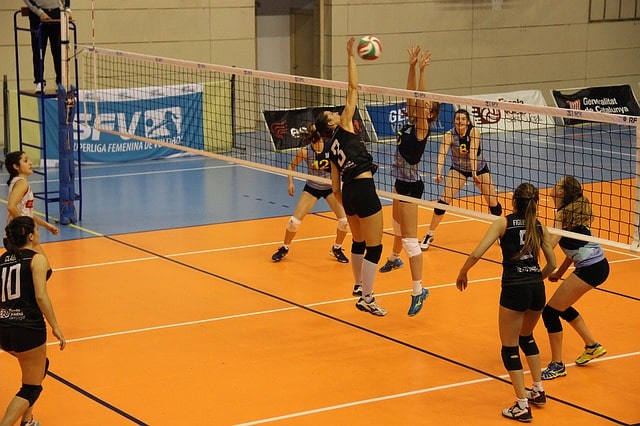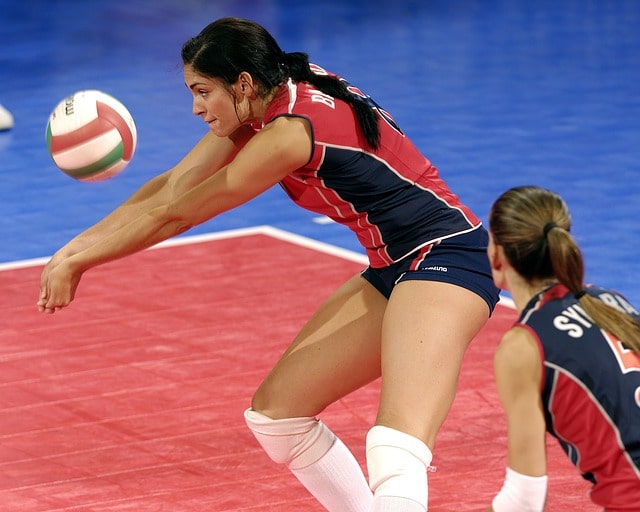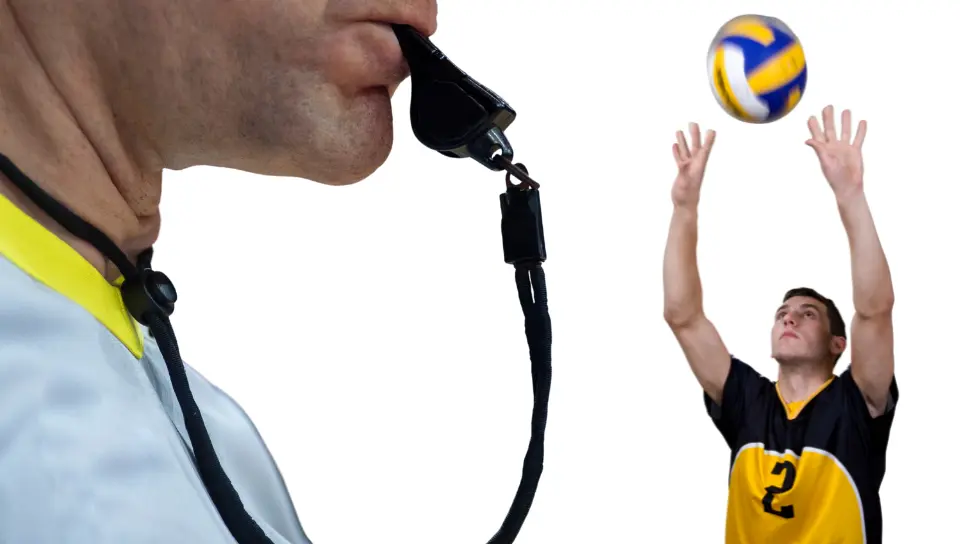VOLLEYBALL RULES AND FUNDAMENTALS
In Volleyball Rules and Fundamentals you will find a special summary of the Rules and Technical Fundamentals of Volleyball in a simple and objective way.
01 – How Big is the Volleyball Court?
The official volleyball court is a rectangle, measuring 18 meters long and 9 meters wide. All lines on the Volleyball court are 5 centimeters wide.
02 – What is the Height of the Official Volleyball Net?
- The official Volleyball net has a height of 2.24 meters for women’s games and 2.43 meters for men’s games.
- The posts are 2.55 meters high and are 0.50 to 1 meter from the sideline.
- The Volleyball net is 1 meter high by 9.50 to 10 meters wide.
- The Volleyball net antennas must be flexible and measure 1.8 meters.
- The antennas are fixed to the net over the court’s sidelines.
- The antenna serves to delimit the area where the ball crosses over the net.
03 – How Many Players Form a Team?
Usually, a complete Volleyball team consists of 12 players, a coach and up to two assistants, a physiotherapist, and a doctor. Yet, 14 players may be recorded on the score sheet, according to the following rules:
- Less than 12 players: possibility of 1 libero.
- 12 players: possibility of 1 or 2 liberos.
- 13-14 players: mandatory of 2 liberos.
The equipment of the players consists of a shirt, shorts, socks and sports shoes. All players must wear equal uniforms except the libero. The shirts will be numbered 1 to 20. Players may wear glasses or contact lenses as long as they are responsible for the risks.
OBSERVATION: The coach and the team captain are responsible for the conduct of their teams. The libero cannot be the captain.
04 – How Many Sets a Volleyball Match Has?
- One official Volleyball match is played in a best of 5 sets (3 winning sets for a team).
- Wins a set the team who first makes 25 points, with a minimal advantage of 2 points.
- In case of a draw in 24 x 24, the set should continue until one of the teams has an advantage of 2 points. Ex.: 26 x 24 or 27 x 25 or 28 x 26.
- Wins the match the first team to win 3 sets.
- In case of a tie in 2 x 2 sets, the 5th set, or Tie Break will be played, until 15 points, with the minimal difference of 2 points.
05 – THE ROTATION IN VOLLEYBALL
When a receiving team wins a Rally, gets the right to serve, their players must rotate a position clockwise. The player who was in position 2 (right front) will go to position 1, the player who was in position 1 goes to position 6, the player who was in position 6 goes to position 5 and so on.
- Three players must form the front zone, position 4 (left front), 3 (middle front) and 2 (right front).
- Three players must form the back zone: 5 (left back), 6 (middle back) and 1 (right back).
- After the service, the players can move freely around the court.
06 – Number of Contacts
A team may perform up to 3 contacts before sending the ball to the opponent team. Block touching does not count as a contact.
6.1 – Volleyball Four Contacts
The team which makes more than three contacts is committing a foul.

07 – Volleyball Double Contact
A player may not have two consecutive contacts to the ball. A touch on block does not count as the player’s first contact.
08 – Hold in Volleyball
Is not allowed to hold, throw or push the ball, it has to be struck or hit.
09 – Penetration Over the Net
It’s not allowed to touch the ball on the opponent’s side of the court until he finishes his action of attack.
9.1 – Penetration Under the Net
Is allowed to penetrate the opponent space under the net, since:
- It doesn’t interfere on the opponent action;
- A part of the foot stays on the central line.
10 – Volleyball Net Foul
- Any contact with the net, in the space between the antennas, is a foul.
- A player contact with the net, due the net movement after a ball hit on it, is not considered a foul.
- Touching the posts, net fixing cables or any material outside of the space between the antennas, is not considered a foul.
VOLLEYBALL FUNDAMENTALS
WHAT ARE THE FUNDAMENTALS OF VOLLEYBALL?
The Fundamentals are the techniques and skills used by players in the game of Volleyball. The main Fundamentals are the Service, Reception or Pass, Setting, Attack, Block and Defense.
THE SERVICE IN VOLLEYBALL
The service is one of the main fundamentals, is the act of putting the ball into play. In the language of Volleyball, the service is the foundation that starts a Rally. A well-executed service is one that makes it difficult for the opposing team to receive (pass), will make the players of the receiving team have to move away from their positions and have more difficulty to perform an attack.
“Volleyball Rally is all the actions that happen in the game from the moment a service is made until the moment a team scores a point. With each new service, a new Rally starts. ”
By the FIVB Volleyball Rules, the serving player must be behind the end line of his court, a region called service zone.
Related Service Rules
“The Volleyball service zone is a 9-meter wide area behind the end line on either side of the court.”
TYPES OF SERVICE
There are three types or styles of Volleyball service: Under Service, Float Service, and Jump Service.
THE UNDER SERVICE
It is a slower type of service in which the ball travels higher over the net. It is the most suitable service for beginners in Volleyball.
PERFORMING THE UNDER SERVICE
If you are right-handed, hold the ball with your left hand at your waist, with your right hand closed, your thumb out, hit the bottom of the ball hard enough that it overtakes the net and falls into the adversary court. If you are left-handed, just do the same movement, switching the hands.
Learn the Loot From Above
The Loot on top is a faster and more efficient loot, even used by professional players.
EXECUTION OF THE LOOT ON TOP
Hold the ball with one or both hands, throw it up, up the head, hit the ball with the palm of your hand.
VOLLEYBALL FLOAT SERVICE
The Float Service is faster and more efficient, used also for professional players.
PERFORMING THE FLOAT SERVICE
Hold the ball with one or both hands, toss it over the head and hit the ball with the palm of your hand.
RECEPTION IN VOLLEYBALL
The Reception is one of the Volleyball Basics Fundamentals, it is the act of receiving the opposing service and passing the ball to the team setter. The reception is the first of three contacts allowed for each team.
The most used technique in the reception is the dig (see image above). It is important during the dig execution, that the ball has contact with both forearms.

SETTING IN VOLLEYBALL
The setting is usually the second contact of the three rings allowed for each team. The most commonly used technique for performing is the set. However, the setting can also be done with a dig.
The goal of the setting is to raise the ball near the net for a teammate to perform an attack.
Related Setting Rules
“If the Libero is in the front zone and makes a setting using both hands (sett), his teammates cannot attack the ball above the upper edge of the net.”
ATTACK IN VOLLEYBALL
The attack is most often the third contact with the ball, allowed to each team. The most used technique in the attack is a sequence of running approach, jump and hit the ball with one hand. Usually, the attack is done by bouncing and hitting the ball with the palm as hard as possible and downwards.
DEF TIP
The tip is a type of non-force attack when a player jumps to perform an attack and instead of making a strong hit, he controls the ball with his fingertips to deflect the opposing block.
BLOCK IN VOLLEYBALL
The Block (see image) is a defensive action that aims to block the attack and send the ball back to the opposing court.
The block can be single (one player), double (two players) or triple (three players).
Related Block Rules
“Is not allowed to block the adversary service”
“The libero cannot block or attempt to block”
DEFENSE IN VOLLEYBALL
The defense is a fundamental that can be performed with any part of the body, including the feet. The goal of the defense is to prevent the success of the attack of the opposing team.
The defense is such an important fundamental in Volleyball that there is an expert defensive player, the libero.
MORE VOLLEYBALL CONTENT
- Volleyball Court
- The History of History
- All Volleyball Rules
- Video Class Volleyball Basics
- Volleyball Tactics
- Volleyball Positions
- Volleyball Rotations
